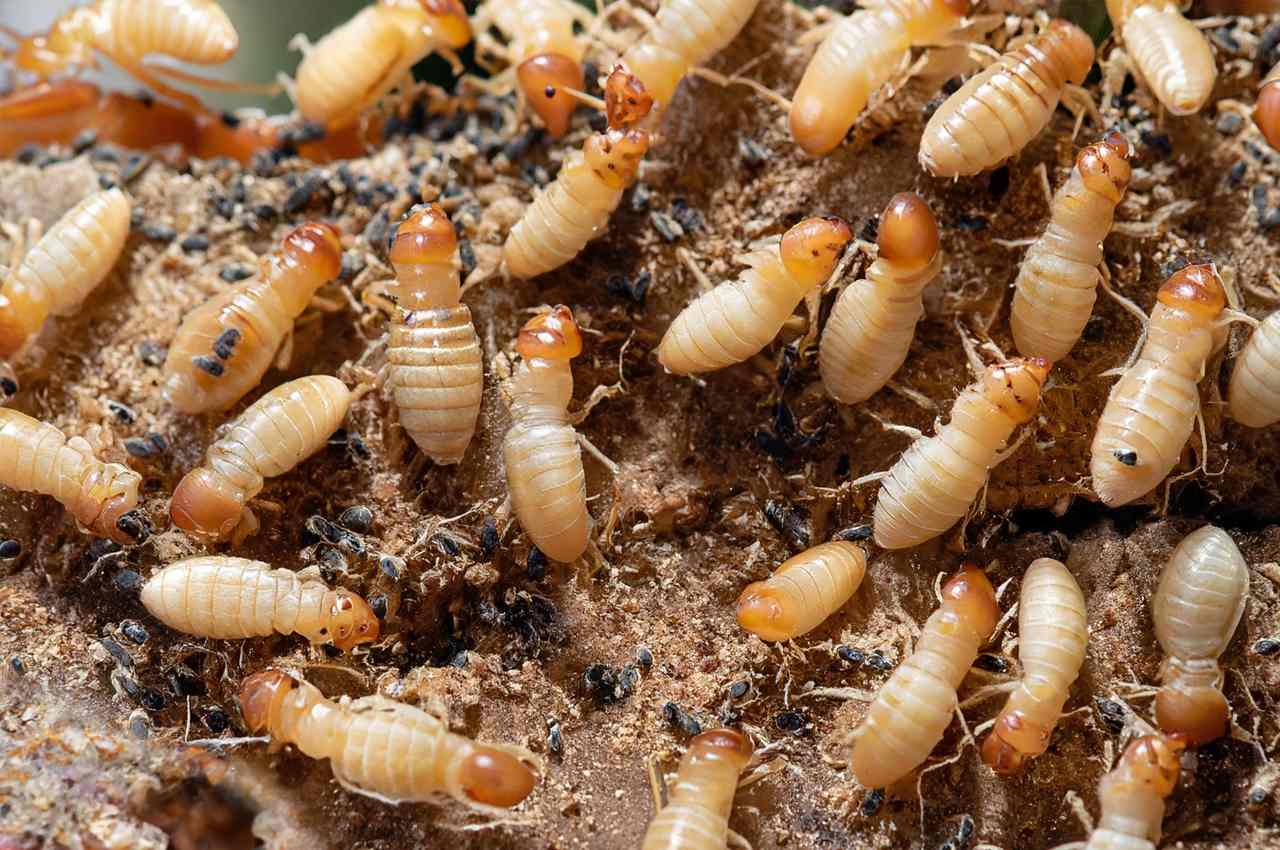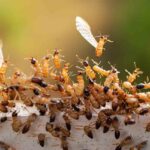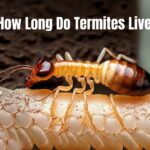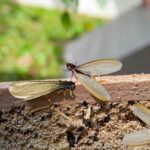Figure out how many termites in a colony make up an infestation. Termites, those obstinate wood-eating insects, often cause homeowners anguish. Effective pest treatment depends on knowing termite colonies, especially how many termites are found there. In this thorough blog article, we’ll set out on a quest to learn the mysteries of termite colonies, investigating the elements that affect their growth, the function of several castes, and practical methods for dealing with these quiet scavengers.
How Many Termites in a Colony?
Number of termites in a colony depends on species, age, and food availability. The typical US termite colony has 60,000 individuals. However, this number varies greatly. Some termite species may develop colonies of a few hundred to several million. Age also matters; small colonies may contain just a few hundred termites, whereas adult ones might have 2 million. Subterranean termite colonies are larger than drywood termite colonies. Additionally, the queen termite may produce up to 30,000 eggs every day, affecting colony growth. Finally, food supply is crucial; when a colony runs out, its population declines. Consider these criteria and contact pest control specialists to properly treat termite infestations and safeguard buildings.
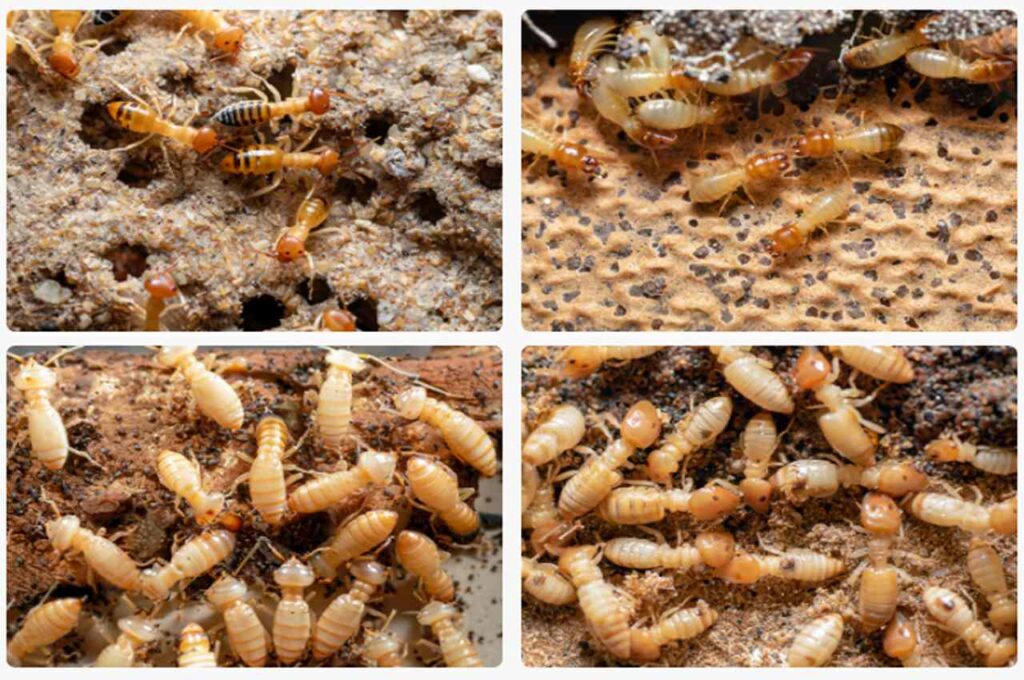
Termite Species and Their Typical Colony Sizes
| Termite Species | Typical Colony Size Range |
|---|---|
| Subterranean Termites | Several hundred thousand to several million |
| Drywood Termites | Thousands |
| Dampwood Termites | A few hundred to a few thousand |
| Formosan Termites | Millions (notorious for large colonies) |
| Conehead Termites | Several hundred thousand to a few million |
| Desert Termites | Thousands to tens of thousands |
The Social Structure of Termite Colonies
We must first comprehend the complex social structure that termites have developed in order to comprehend the number of termites in a colony. Termite colonies are structured like well-run towns, with each member contributing in a particular way to the colony’s existence.
Termite colony castes
| Caste | Responsibilities |
|---|---|
| Workers | Foraging, feeding, nest building |
| Soldiers | Defending the colony from predators |
| Nymphs | Developing into workers, soldiers, or reproductives |
| Reproductives | Kings and queens responsible for reproduction |
The majority of the colony is made up of workers who carry out necessary activities like gathering food and building elaborate tube networks. Soldiers with strong jaws guard the colony from outside dangers, mostly ants. The nymphs represent the colony’s future; depending on the demands of the colony, they will develop into laborers, soldiers, or reproductives. The king and queen are reproductives, and they are what keep the termite species alive.
How big termite colonies are
Let’s go right to the point: how many termites are there in a colony? A termite colony’s size is not constant and may change dramatically depending on a number of variables.
Different Colony Sizes
Termite colonies may include anything from a few hundred to several million people! The termite species, the surrounding environment, and the colony’s age are the main determinants of size.
- Subterranean termites: Known for their capacity for destruction, subterranean termites often form enormous colonies with several million members. Their insatiable desire for wood may seriously harm structures.
- Drywood Termites: In comparison, drywood termites often have smaller colonies. Thousands, not millions, of termites make up these colonies on average.
- Dampwood termites: Termites that like moist wood are known as dampwood termites. Their colonies may have between a few hundred to a few thousand members, making them of average size.
Colony Size Influencing Factors
The size of a termite colony depends on a number of variables. To understand the dynamics of termite infestations, it is crucial to appreciate these elements.
- Age of the Colony: The age of the colony itself has a significant impact on colony size. A termite colony steadily expands in size as it gets older. While elder colonies may number in the millions, younger colonies may only have a few hundred individuals.
- Environment: The size of the termite colony is greatly influenced by environmental conditions. Temperature, humidity, and the availability of food are important factors. While hostile settings could prevent colony formation, ideal circumstances might promote fast colony expansion.
| Factors | Influence on Colony Size |
|---|---|
| Age of the Colony | Older colonies tend to be larger. |
| Environmental Conditions | Favorable conditions can promote rapid colony growth. |
| Termite Species | Different species naturally exhibit varying sizes. |
| Access to Resources | Adequate food sources can lead to larger colonies. |
Differences in colony sizes among different termite species occur naturally. To put efficient pest control measures in place, it’s essential to identify the precise species that are infesting your home. The termite species are further examined below:
| Termite Species | Colony Size Range |
|---|---|
| Subterranean Termites | Several hundred thousand to several million |
| Drywood Termites | Thousands |
| Dampwood Termites | A few hundred to a few thousand |
Your decision of the best termite management strategy might be influenced by your knowledge of the termite species present on your property.
Termite infestation detection and management
Early termite infestation detection is essential for reducing damage. The following are some warning indicators to look out for:
1. Mud Tubes: Mud tubes are built by underground termites along walls or foundations. These tunnels function as termite protection and are an obvious sign of termite activity.
2. Wood Damage: Watch out for timber that seems to have been harmed or hollowed out. Termites consume wood inside, leaving behind a thin veneer that may be hollow to the touch.
3. Discarded Wings: Termites lose their wings after swarming. A colony is close if you find abandoned wings near windowsills or other entryways.
4. Fecal Pellets: Fecal pellets, which resemble microscopic wood-colored grains, are often expelled by drywood termites. The presence of these pellets close to wooden buildings indicates an infestation.
5. Audible clicking: When threatened, soldier termites may make a clicking noise. In suspected termite regions, pay close attention to what you hear.
It’s critical to contact expert pest control services right away if you suspect a termite infestation. To achieve efficient eradication, dealing with termites demands specialist expertise and equipment.
Termite infestation prevention
The most effective strategy to deal with termites is often prevention. Here are some steps you can do to avoid this:
1. Schedule Regular Inspections: If you reside in an area where termite activity is likely, schedule regular inspections of your property for termites.
2. Reduce Moisture: Take care of any moisture problems in your house since termites are drawn to wet areas. Ensure appropriate ventilation and repair leaking pipes.
3. Wood Maintenance: Routinely check the foundation, decks, fences, and other wooden structures. Any wood that is broken should be replaced right away.
4. Termite Barriers: To prevent termites from accessing your house, think about erecting chemical or physical termite barriers around it.
5. Professional Treatments: Hire a reputable pest control company to treat your house with preventive measures.
Conclusion
Depending on variables including termite species, colony age, and climatic circumstances, the population of termites in a colony may range greatly, from a few hundred to several million. For efficient termite management and to safeguard your home from these quiet but devastating pests, it is crucial to comprehend these principles.
Frequently Asked Questions
How many king termites in a colony?
A termite colony usually has one king termite. The king’s main job is to mate with the queen termite and lay eggs. King termites are bigger than other colony members and have long, thin bodies and conspicuous wings. These wings help the king and queen termites leave the colony to marry during their nuptial flight. King and queen termites drop their wings and start a new colony after this journey. In the new colony, the king mates with the queen, produces eggs, and cares for the young termites. Even though king termites have long lives, they die. After the king dies, the queen termite may mate with a worker to generate young kings.
How many queen termites in a colony?
The species and colony size determine the amount of queen termites. Subterranean termites have one queen termite that may produce up to 30,000 eggs every day. Other species, like dampwood termites, have numerous queen termites that cooperate together to lay eggs and raise young termites. Queen termites are noticeable for their huge size, big oval bodies, and nuptial flying wings. After this flight, the king and queen termites lose their wings and start a new colony, where the queen mates with the king and produces eggs. Despite their lengthy lifespans, queen termites die, and the colony’s existence relies on their replacement.
How many cathedral termites are in a colony?
The number of cathedral termites (Nasutitermes triodiae) in a colony is not definitively known. These Australian termites build cathedral-like nests. Studies have shed light on their colony size, however there is no unanimity. A cathedral termite colony may have up to 100,000 termites, according to a small sample size, whereas a bigger research found an average of 50,000 termites. The rarity and restricted geographic range of cathedral termites must be acknowledged. Cathedral termite colonies are rare, and their colony size is unknown.
How many termite colonies per acre?
Southern Pest Control reports 13–14 termite populations per acre. This value might vary greatly depending on geography, climate, and termite kind. The most prevalent termite species in the US, subterranean termites, thrive in warm, humid settings and are distributed nationwide. Warm and arid environments are home to drywood termites that infest furniture and attic timbers. Less common dampwood termites favor decaying logs and stumps. More predators, such as birds, ants, and other insects, may reduce termite infestations.
How many termites does it take to start a colony?
The king and queen termites must be mated to start a new termite colony. Royal termites build their colony in damp soil near a food supply. They then build a nest and deposit eggs. Workers hatch from these eggs and care for the queen, eggs, food, and nest. The colony generates additional workers and reproductives, which breed to form new colonies. At least one married couple of termites are required to form a colony, depending on species.
Do termites live in colonies?
Yes, termites indeed live in colonies, displaying highly organized social behavior and behave quite systematically. These colonies have castes with separate duties. The queen lays up to 30,000 eggs every day, and the king mating with her is the caste’s main job. The most abundant caste, workers, forage for food, build nests, and care for the queen and eggs. Soldiers protect the colony from predators with powerful bites and stings. Termite colonies may have a few hundred to several million members, depending on the species. These colonies help ecosystems break down rotting wood and organic debris, but they may also harm buildings and structures.
Do all termite species have the same size colonies?
There are more than 2,700 species of termites that have been identified, and they differ significantly in terms of colony size. Others, like drywood termites, often develop much smaller colonies, frequently in the thousands, although other species, like subterranean termites, may have colonies that number in the millions.
Can a termite colony's size change over time?
A termite colony’s size might alter over time. A colony tends to expand in size as it gets older, with certain species having the capacity to have millions of members. The availability of resources and the environment both influence colony growth.
Are all termites within a colony active at the same time, or do they have different roles?
Each termite in a colony plays a certain duty. Workers, soldiers, nymphs, and reproductives (kings and queens) are only a few of the castes that make up the colony. Workers are the most numerous and are in charge of activities like nest construction and foraging, while soldiers guard the colony. These castes ultimately emerge from nymphs according to their needs, and reproductives are in charge of procreation.
How can I find how big a termite colony is on my property?
Without expert guidance, determining the size of a termite colony on your property may be difficult. To determine the size of a colony, pest management professionals employ methods including bait stations, monitoring, and inspection. Without the right information and resources, estimating colony size might be erroneous.
What factors may affect the growth of a termite colony?
A number of variables, including the age of the colony, the environment (such as temperature and humidity), and the termite species, may affect the development of a termite colony. Positive environmental factors encourage development, older colonies have a tendency to be bigger, and various termite species naturally have variable colony sizes.
How long does it take a termite colony to mature?
Depending on the species and surrounding circumstances, a termite colony’s maturation period might change. A colony may take many years to grow and expand to its maximum size on average. For instance, subterranean termite colonies may develop after five to seven years.
Can there be more than one queen in a termite colony?
Yes, some termite species have colonies with multiple queens, a phenomenon known as polygyny. Multiple queens may hasten egg production, enabling more rapid colony expansion. But not every species of termite behaves in this way.
What are the signs of a termite infestation, and do they indicate the size of the colony?
Mud tubes, wood damage, abandoned wings, fecal pellets, and loud clicking noises are indications of a termite infestation. While these indications point to the existence of termites, they may not necessarily be a good indicator of the colony’s size. Accurate colony size estimation requires professional examination.
What is the best way to manage a termite colony on my property?
Experienced pest control services are necessary to deal with a termite colony. Experts in pest management may use a variety of techniques, such as chemical treatments, physical barriers, and baiting, to get rid of termites and guard your home from more harm. It is typically not advised to use DIY termite control methods.
- How do termite mounds help regulate temperature? - 7 January 2024
- 10 Effective Termite Control Methods That Actually Work - 4 January 2024
- How Long Does It Take for a Termite Mound to Form? - 21 December 2023
